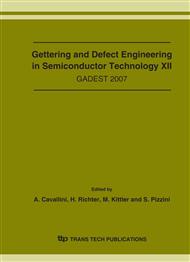p.155
p.161
p.167
p.175
p.183
p.189
p.195
p.201
p.207
Detection of Nickel in Silicon by Recombination Lifetime Measurements
Abstract:
The impact of nickel on minority carrier recombination lifetime has been studied in ptype CZ silicon using SPV and μ-PCD techniques. The results show that small oxide precipitates can be used to improve drastically the detection limit of nickel. This is explained by the decoration of oxide precipitates by nickel, which results in the enhanced recombination activity. In the absence of oxide precipitates or other related bulk microdefects nickel precipitates preferably to wafer surfaces, which does not have such a high impact on the measured recombination lifetime, at least on a low concentration level. Low temperature anneal at 180°C or light illumination of the wafers after nickel in-diffusion did not reveal any further change in lifetime in any of the wafers, which may indicate that nickel precipitates efficiently during air-cooling from high temperature.
Info:
Periodical:
Pages:
183-188
Citation:
Online since:
October 2007
Keywords:
Price:
Сopyright:
© 2008 Trans Tech Publications Ltd. All Rights Reserved
Share:
Citation:


